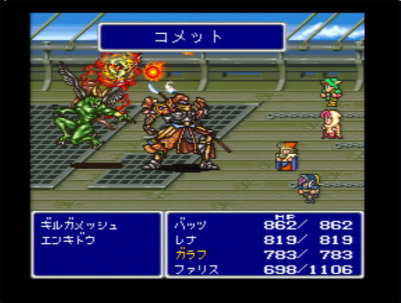We continue our journey with the "Golden Age" of Final Fantasy
Final Fantasy V: The Game Lost to Time


Continuing on the wave of success, the “dream team” over at Square went back to work after the completion of Final Fantasy IV. Sakaguchi once again directed, but also wrote the story that would become Final Fantasy V. Yoshitaka Amano provided character art and designs, as well as creating the logo for the game, but he was assisted by a hotshot new artist, Tetsuya Nomura.
Nomura worked on monster designs and some battle screen graphics for this iteration of Final Fantasy. This was his first project for the company. He would go on to become the artistic face of Square Enix, providing character designs for Final Fantasy, Kingdom Hearts, and Parasite Eve among other games. Final Fantasy V was released for the Super Famicom in December of 1992.

Tetsuya Nomura
Final Fantasy V was an interesting entry in the series, as it seemed to combine elements of the older Famicom games with the story and presentation of Final Fantasy IV. Instead of a shifting party of twelve characters, Final Fantasy V had a cast of five: Bartz, Galuf, Faris, and Lenna (Krile would replace Galuf in the party at a specific moment in the story).
While the story featured the gravitas and melodrama that FF IV introduced, it took a backseat to the game mechanics. Active Time Battle returned, but this time players could see when a character was about to take a turn thanks to a handy time meter next to the character hit points. The Job System from Final Fantasy III returned, but with vast improvements. This time the party earned Ability Points in addition to Experience Points. Ability Points helped level the particular job a character was on at the time, and leveling up jobs would unlock new abilities. These extra abilities could be assigned to a secondary command bar, allowing for dual class specialization for the first time in the series. In this way, it was possible to make a Black Mage that could use summoning magic or a Warrior that could dual wield weapons like a Ninja. This added yet another layer of strategy and customization to the battle system, and many fans of the series cite Final Fantasy V as having the most engaging game mechanics of the series.

The game continued the trend of each game surpassing the sales of the previous release, with Final Fantasy V selling over 2 million units in Japan. A translation was in the works for America, but plans fell through. However at this point in video game history, American gamers were starting to become more aware of the video game scene in Japan. Unlike Final Fantasy II and III, gamers in the West were aware of the existence of Final Fantasy V, thanks to import previews from magazines such as Electronic Gaming Monthly. That magazine in particular had a small preview of Final Fantasy Extreme, which was another attempt to bring the game to the West. At the time, it was hinted that the gameplay of Final Fantasy V was simply too complex for American audiences. Finally, the company Top Dog Software attempted to bring the game to PCs in America, but this also ended up dead in the water. This would lead to Final Fantasy V getting one of the first fan translations. It wasn’t until the release of Final Fantasy Anthology on the PlayStation in 1999 that American gamers would finally have an official way of enjoying the game.

Due to its long journey to America and its complex job system, Final Fantasy V has become the de facto “black sheep” of the 16 bit era. It has its staunch supporters, but the game didn’t review as favorably as the other two games to come out for the Super Nintendo. However, it has become a fan favorite for marathon sessions, and an informal yearly event called the Final Fantasy V Random Job Challenge (where players randomly select one permanent job for each party member) has become a staple for fans of the game.









Comments